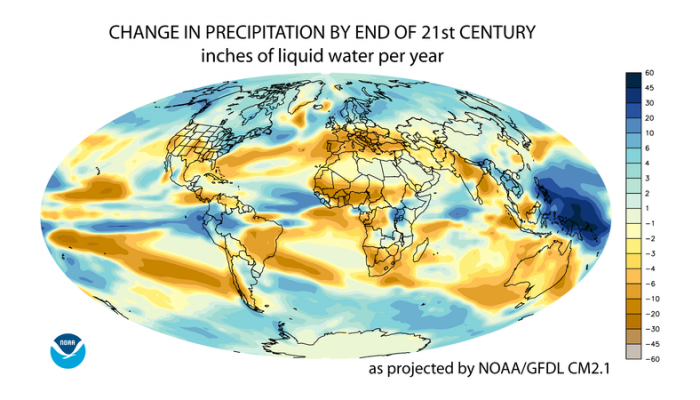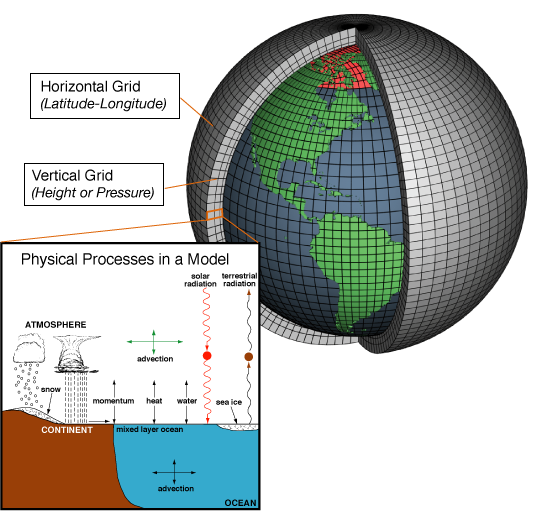
Our climate is constantly changing, and with the help of simulation modelling, scientists are working hard to better understand just how these conditions will change and how it will affect society. Science journalist Conor Paul Purcell has worked on Earth System Models during his time as a PhD student and postdoctoral researcher; today he explains how scientists use these models as tools to forecast the future of our climate.
While we can’t predict everything about our future, climate scientists have a good understanding of how our environment will look and feel like in the coming years. Researchers and climate specialists predict that temperatures will increase dramatically in the 21st century, ranging between 1.5°C and 4°C above pre-industrial levels, depending on your location and the amount of carbon dioxide pumped into the atmosphere in the near future. Forecasts of future drought and flood risk, at both regional and global bases, are also provided by climate experts.
Understanding how such features of Earth’s changing climate may manifest, and ultimately impact on our society, takes considerable international collaboration – a collaboration which is largely based around the results of climate modelling. That’s because climate predictions for the future are made using sophisticated computer models, which are built around mathematical descriptions of the physical and biological processes that govern our planet.
These models have become so complex in recent years that they are now referred to as Earth System Models (ESMs). Using ESMs, climate modellers can create simulations of the planet at different times in the future and the past. ESMs are in fact the only tools we have for simulating the global future in this sense. For instance, if we want to know how our climate may look like one hundred years from now, how ocean acidification levels may change and how this might impact ocean life, or how plants will respond to increasing levels of atmospheric carbon dioxide, ESMs are the only tool available.
The models are built in components, each representing a separate part of the Earth system: the atmosphere, the ocean, the land surface and its vegetation, and the ice-sheets and sea-ice. These are constructed by coding each component with the mathematics that describes the environmental processes at work.

Climate models are systems of differential equations based on the basic laws of physics, fluid motion, chemistry, and biology. Pictured here is a schematic of a global atmospheric model. (Credit: NOAA, via Wikimedia Commons)
For example, the winds in the atmosphere are described by the mathematics of fluid motion. Model developers translate these mathematical equations into code that computers can understand, like giving them a set of instructions to follow. Supercomputers can then interpret the code to simulate how winds, for example, are expected to develop at each global location through time. The results are usually plotted on world maps.
As scientists have learned more about our Earth’s systems over time, the complexity of these individual models has been ramped up dramatically. For example, the land surface and vegetation model components become more sophisticated as plant biologists understand more and more about how plants transfer water and carbon between the land and atmosphere.
And it’s not just one giant solo project either: there are tens of ESMs and hundreds of subcomponent models developed and used at research centres around the globe. Collaboration between these facilities is a necessary part of progress, and information is shared at international conferences ever year, like the American Geophysical Union’s Fall Meeting in the United States and the European Geosciences Union’s General Assembly in Europe.
This means that developments are always been made towards increasing the realism of ESMs. On the horizon such developments will include increasing the resolution of the global models for improving accuracy at regional locations, and also incorporating the results from the latest research in atmospherics, oceanography and ice sheet dynamics. One example is research into plants, specifically how they interact with carbon dioxide and water in the atmosphere. Further understanding of this biological process is expected to increase the realism of models over the coming years and decades. In general, improvements to the accuracy of model simulations can help to help society in the future. For example, models will be able to help predict how climate change may impact, say, water scarcity in South Africa, wildfire risk in the western United States, or crop yields in Asia. Indeed, the ESMs of the future should boast incredibly accurate simulations and prediction capabilities unheard of today.
By Conor Purcell, a Science & Nature Writer with a PhD in Earth Science
Conor Purcell is a science journalist with a PhD in Earth Science. He is also founding-editor of www.wideorbits.com and is on twitter @ConorPPurcell and some of his other articles at cppurcell.tumblr.com.



